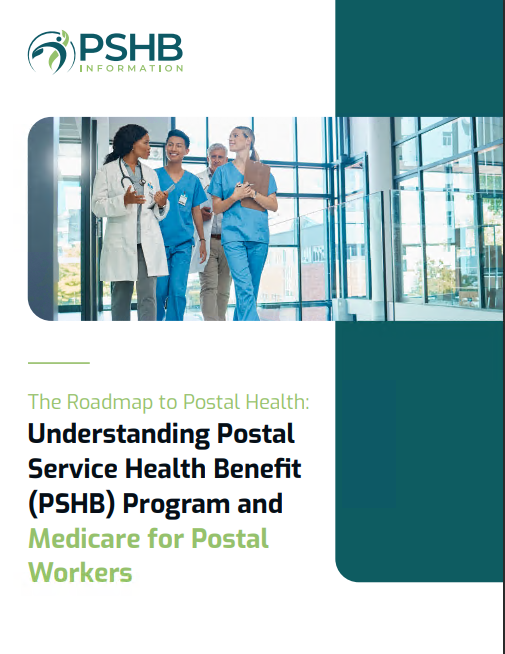Key Takeaways
-
If you’re enrolled in both PSHB and Medicare Advantage, you could end up with overlapping or conflicting coverage—which might cost you more, not less.
-
PSHB plans already include generous benefits and Medicare integration, so adding a separate Medicare Advantage plan may create unnecessary complications.
Understanding How PSHB Works with Medicare
The Postal Service Health Benefits (PSHB) program was created to provide more tailored healthcare options for USPS retirees and employees. As of 2025, it replaces FEHB for postal workers and annuitants, and its structure aligns closely with Medicare for those aged 65 and older.
If you’re enrolled in Medicare Part A and Part B, your PSHB plan is designed to coordinate with those benefits. Most PSHB plans for Medicare-eligible enrollees offer features like:
-
Waived deductibles and coinsurance when Medicare is primary
-
Enhanced pharmacy benefits through Medicare Part D integration
-
Potential premium or cost-sharing reimbursement for Part B
These benefits make enrolling in Medicare Part B worthwhile for most postal retirees. However, that doesn’t mean adding a separate Medicare Advantage (Part C) plan is always a good idea.
What Happens When You Add a Medicare Advantage Plan
Medicare Advantage (MA) plans are private plans that replace Original Medicare (Parts A and B). When you enroll in an MA plan, it becomes your primary coverage—not Medicare, and not PSHB. This can lead to several issues:
-
Your PSHB plan may no longer act as your secondary insurer.
-
Some PSHB plans will not coordinate benefits with MA plans at all.
-
You may lose access to certain benefits in your PSHB plan if you rely on your MA plan for primary coverage.
While it might seem like “more coverage” is better, having both can actually reduce the value of each. Instead of working together, they can pull in opposite directions.
Conflicting Coverage Rules Can Cause Billing Confusion
If you’re enrolled in a PSHB plan that integrates with Medicare and also join a Medicare Advantage plan, healthcare providers may be confused about who pays first. Some common issues include:
-
Claims being denied by one plan because the other plan is listed as primary
-
You being billed unexpectedly because neither plan pays
-
Delayed reimbursements and unclear Explanation of Benefits (EOBs)
This kind of overlap may leave you responsible for navigating disputes between the two plans. Even though PSHB is built to work alongside Original Medicare, it generally does not coordinate with Medicare Advantage.
You May Be Paying More Than Necessary
Many retirees are drawn to Medicare Advantage plans because of additional benefits like dental or fitness memberships. But if you’re already in a PSHB plan with Medicare Part B, you’re likely getting similar benefits through your existing coverage.
Adding Medicare Advantage may mean:
-
Paying an extra monthly premium (in addition to your PSHB premium)
-
Losing cost-sharing reductions provided by PSHB when Medicare is primary
-
Confusing network restrictions that don’t match your PSHB coverage
In other words, you might pay more out-of-pocket for a plan that doesn’t enhance your healthcare experience—and could even limit it.
Medicare Part D Conflicts
Under the PSHB system, if you’re Medicare-eligible, your prescription drug coverage is provided through a Medicare Part D Employer Group Waiver Plan (EGWP). This coverage is automatically included with your PSHB plan.
If you enroll in a Medicare Advantage plan that includes prescription coverage (known as an MA-PD), it can cancel your EGWP enrollment. That means:
-
You lose the integrated drug coverage from your PSHB plan
-
Your costs could go up, depending on the MA-PD plan’s structure
-
You might have to wait until the next Open Season to re-enroll in your PSHB drug coverage
And once you drop EGWP coverage tied to your PSHB plan, rejoining later isn’t guaranteed.
What About Medicare Advantage PPOs?
Some Medicare Advantage plans are PPOs that claim to work alongside other coverage. But even in these cases, PSHB plans typically won’t coordinate benefits with them.
A PPO Medicare Advantage plan still becomes your primary payer, and:
-
Your PSHB plan may not pay second
-
Your provider may not bill both plans
-
You could face more complex preauthorization rules or out-of-network restrictions
Even though a PPO might sound flexible, in reality, it might not work the way you expect if you’re already enrolled in PSHB with Medicare.
Network Disruption Risks
PSHB plans often allow broad access to providers nationwide, especially when Medicare is the primary payer. But when you join a Medicare Advantage plan, you’re typically restricted to a specific provider network.
Some consequences:
-
You may have to change doctors or hospitals
-
Out-of-network services may not be covered or will cost more
-
Access to specialty care could be limited based on plan contracts
This change can be particularly difficult if you split time between multiple states or require care from specialists who are not in your MA plan’s network.
When It Might Make Sense to Consider Medicare Advantage
There are only limited circumstances where enrolling in a Medicare Advantage plan alongside PSHB might make sense:
-
You’ve opted out of PSHB (e.g., you have TRICARE or CHAMPVA instead)
-
You live in an area with limited PSHB provider access and a high-performing local MA plan
-
You are no longer eligible for PSHB as a retiree or dependent
In these cases, Medicare Advantage may serve as your main source of coverage. But for most postal retirees eligible for PSHB with Medicare, the better coordination and fewer restrictions make sticking with your PSHB plan the smarter route.
Enrollment Timing Matters
If you’re considering changing plans, know that timing matters. PSHB changes can generally only be made during the Open Season (November to December).
Similarly, Medicare Advantage changes follow their own enrollment windows:
-
Initial Enrollment Period (IEP): Around your 65th birthday
-
Annual Election Period (AEP): October 15 to December 7
-
Medicare Advantage Open Enrollment Period: January 1 to March 31 (if already enrolled in an MA plan)
If you switch into or out of a Medicare Advantage plan at the wrong time, you could lose access to your PSHB drug coverage or even disrupt your medical care. It’s important to understand how one enrollment decision affects the other.
Keep Your Coordination Simple
The PSHB system is already designed to give you enhanced benefits once you enroll in Medicare. For many postal retirees, this means:
-
Minimal out-of-pocket costs
-
Reduced or waived deductibles
-
Prescription drug coverage that meets federal standards
Layering a Medicare Advantage plan on top adds administrative friction and may undo many of these advantages. Before enrolling in an MA plan, ask yourself whether it truly offers anything your PSHB coverage doesn’t already include.
Keeping PSHB and Medicare Working for You
If you’re enrolled in the PSHB program and eligible for Medicare, your coverage is already built to work together. Adding a Medicare Advantage plan may disrupt this balance, cost more, and cause confusion for both you and your providers.
Stick with the PSHB-Medicare combination unless you have a very specific reason to switch. And before you make any changes, get in touch with a licensed insurance agent listed on this website to go over your options in detail.









